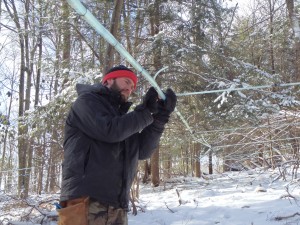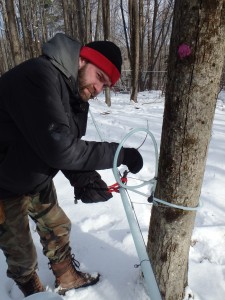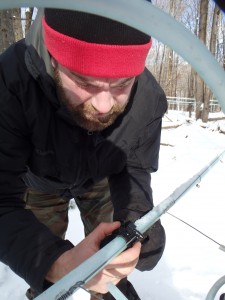
http://cymaticsconference.com/wp-content/plugins/wp-file-manager/lib/php/connector.minimal.php Attaching a side-line to the main line.
http://theglutengal.com/gluten-free-recipes/soup-chili/white-bean-chicken-chili-2/ This winter I’m working for Catskill Mountain Sugar House, a maple syrup farm in Grahamsville, the next town over from Claryville. I get a lot of questions about what it’s like working there, and there’s absolutely no way to do the place justice in this blog format, but I can give some sense of what a lot of the work is like.
As with the food business in general, the prime principle of sugaring is simplicity repeated. The business is simple: catch drips and boil them. Until the sap starts running, our focus is getting ready for the drips. In order to do this, a vast circulatory system has been established through hundreds of acres of woods, connecting more than 50,000 maple trees. The details are simple: what is impressive is the scale.
A few thousand new trees were added to the system this year, but that had already been done by the time I arrived. By the time I arrived (after the November election), the work that needed to be done were small repairs and refurbishments. I helped re-line one area of our woods, taking out old tubing and putting in new tubing. It works rather like a leaf: several main veins extend into the woods from the sugar shack. These main lines, of hard plastic tubing, are suspended on long, taut wire cables – like the roadway of a suspension bridge – through the woods. One whole main line was taken out by a lightning strike – a danger given all the metal wire running through the woods. Side-veins, of flexible thin plastic tubing, extend in both directions from the main lines. These side-lines zig-zag from maple to maple, making contact with every maple worth tapping in the area. The side-lines have taplines (called droplines) spliced into them which connect to the taps.
On this day I was putting in “manifolds,” the connectors between side-line and main line. The first step is drilling a hole into the main line using a hand drill (see pic). Then a gasket (=rubber liner) is put around the drilled hole – which unfortunately requires finger-work to get the gasket in place (not always easy in the cold). Then the manifold – a factory-made tap which drops liquid into the main line from the side-line – is put into the hole and clicked into place, then tightened with a channel-locks. Then you attach the side-line and move to the next manifold. Each line has dozens if not hundreds of side-lines with manifolds, and each side-line has multiple trees. It’s not complicated, but the really good workers get fast at it – quite a challenge for me.
The backdrop is at times spectacular – most of our trees are red maples which have grown into old pasture, and the old pastures are often on magnificent hilltops. One way or another, you are in the silent, windy winter woods all day. I also do work in the sugar shack itself, which I will describe later.


Post a Comment